Application of the Design of Experiments and Computational Fluid Dynamics to Bow Design Improvement
Abstract
:1. Introduction
2. Optimization Methods
3. Design Parameter Variation
4. Design Parameter Variation
Computational Method
5. Results and Discussion
5.1. Effects of Design Parameter Variations
5.2. Bow Shape Optimization
6. Conclusions
- It was possible to systematically and effectively determine the main design parameters and interactions between each of the design parameters using DOE for performing hull optimization to reduce the added resistance in waves.
- The single parameters that have a significant effect on the added resistance among the five bow shape design parameters of the ship were DWL, BBV, and BEA; the two-way interaction was predominant in BWL–BFA.
- To verify whether the added resistance value estimated from the response surface module is valid, it was compared with the CFD analysis results of the same condition, through which the validity of the results derived from the response surface model was confirmed.
- Through the CFD analysis on the optimum hull, it was possible to confirm the reduction of added resistance by the reflected wave around the bow smoothly spread to the side.
Author Contributions
Funding
Conflicts of Interest
References
- Vladimir, N.; Ancic, I.; Sestan, A. Effect of ship size on EEDI requirements for large container ships. J. Mar. Sci. Technol. 2018, 23, 42–51. [Google Scholar] [CrossRef]
- Ancic, I.; Theotokatos, G.; Vladimir, N. Towards improving energy efficiency regulations of bulk carriers. Ocean Eng. 2018, 148, 193–201. [Google Scholar] [CrossRef] [Green Version]
- El Moctar, O.; Oberhagemann, J.; Schellin, T.E. Free surface RANS method for hull girder springing and whipping. In Proceedings of the SNAME Annual Meeting, Houston, TX, USA, 16–18 November 2011. No. A56. [Google Scholar]
- Simonsen, C.D.; Otzen, J.F.; Joncquez, S.; Stern, F. EFD and CFD of KCS heaving and pitching in regular head waves. J. Mar. Sci. Technol. 2013, 18, 435–459. [Google Scholar] [CrossRef]
- Kim, J.-H.; Choi, J.-E.; Choi, B.-J.; Chung, S.-H.; Seo, H.-W. Development of energy-saving devices for a full-slow-speed ship through improving propulsion performance. Int. J. Nav. Arch. Ocean Eng. 2015, 7, 390–398. [Google Scholar] [CrossRef]
- Hirota, K.; Matsumoto, K.; Takagishi, K.; Yamasaki, K.; Orihara, H.; Yoshida, H. Development of bow shape to reduce the added resistance due to waves and verification of full scale measurement. In Proceedings of the First International Conference on Marine Research and Transportation, Ischia, Italy, 19–21 September 2005. [Google Scholar]
- Kim, Y.-C.; Kim, K.-S.; Kim, J.; Kim, Y.; Park, I.-R.; Jang, Y.-H. Analysis of added resistance and seakeeping responses in head sea conditions for low-speed full ships using URANS approach. Int. J. Nav. Arch. Ocean Eng. 2017, 9, 641–654. [Google Scholar] [CrossRef]
- Sudarsanam, N.; Ravindran, B. Using linear stochastic bandits to extend traditional offline designed experiments to online settings. Comput. Ind. Eng. 2018, 115, 471–485. [Google Scholar] [CrossRef]
- Galvanin, F.; Marchesini, R.; Barolo, M.; Bezzo, F.; Fidaleo, M. Optimal design of experiments for parameter identification in electrodialysis models. Chem. Eng. Res. Des. 2016, 105, 107–119. [Google Scholar] [CrossRef]
- Im, S.S. Design and Manufacturing Technique of Energy Saving Subsidiary Propulsion Device for Eco-friendly High Efficient Container Ships. Ph.D. Thesis, Department of Mechanical Engineering, Pusan National University, Busan, Korea, 2014. [Google Scholar]
- Seo, G.H.; Kim, H.C. A study on the appendages optimization of a high speed semi-planing monohull using DOE. J. Soc. Nav. Arch. Korea 2014, 51, 184–192. [Google Scholar] [CrossRef]
- Souza, A.S.; dos Santosm, W.N.; Sergio Ferreira, L.C. Application of Box-Behnken design in the optimization of an on-line pre-concentration system using knotted reactor for cadmium determination by flame atomic absorption spectrometry. Spectrochim. Acta Part B 2005, 60, 737–742. [Google Scholar] [CrossRef]
- Matsumoto, K. Ax-Bow: A new energy-saving bow shape at sea. NKK Tech. Rev. 2002, 86, 46–47. [Google Scholar]
- Oh, S.Y.; Kim, S.-C.; Lee, D.-W.; Kim, S.; Ahn, S.K. Magnus measurements of spin-stabilized projectile using design of experiments. In Proceedings of the AIAA Atmospheric Flight Mechanics Conference, Chicago, IL, USA, 10–13 August 2009. [Google Scholar]
- Ferziger, J.H.; Peric, M. Computational Methods for Fluid Dynamics; Springer Science & Business Media: Berlin, Germany, 2012. [Google Scholar]
- Mathews, P.G. Design of Experiments with MINITAB; ASQ Quality Press: Milwaukee, WI, USA, 2005. [Google Scholar]

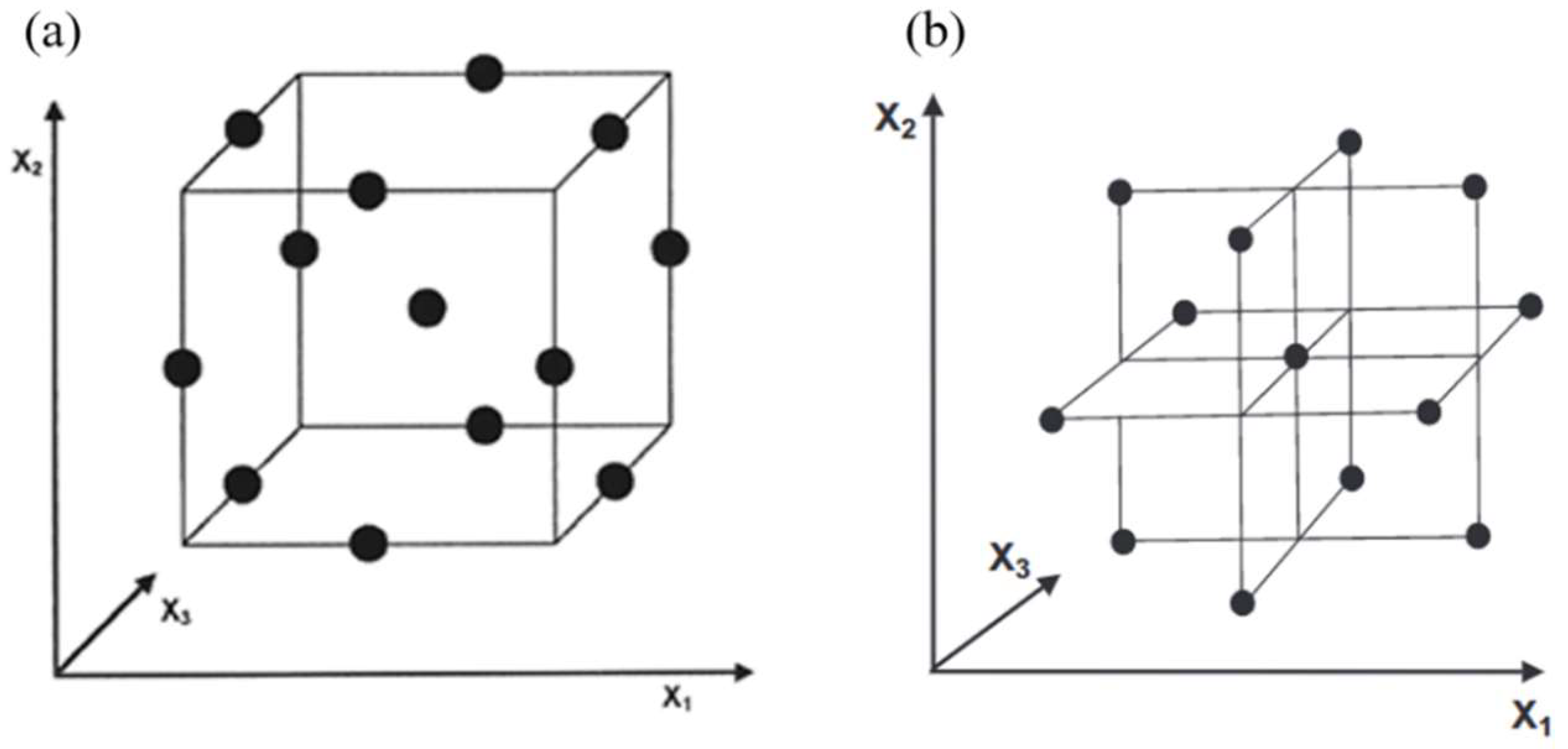



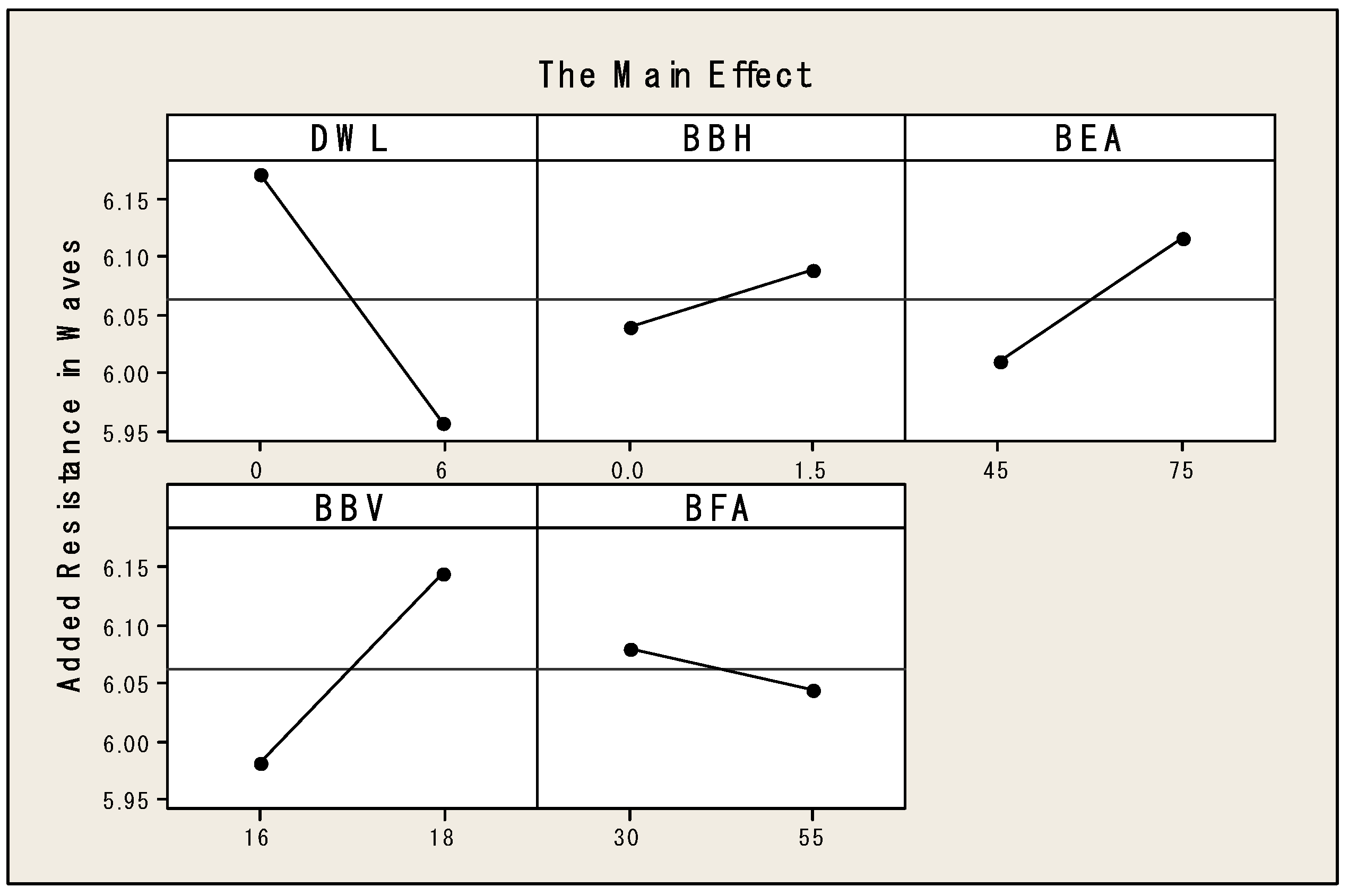


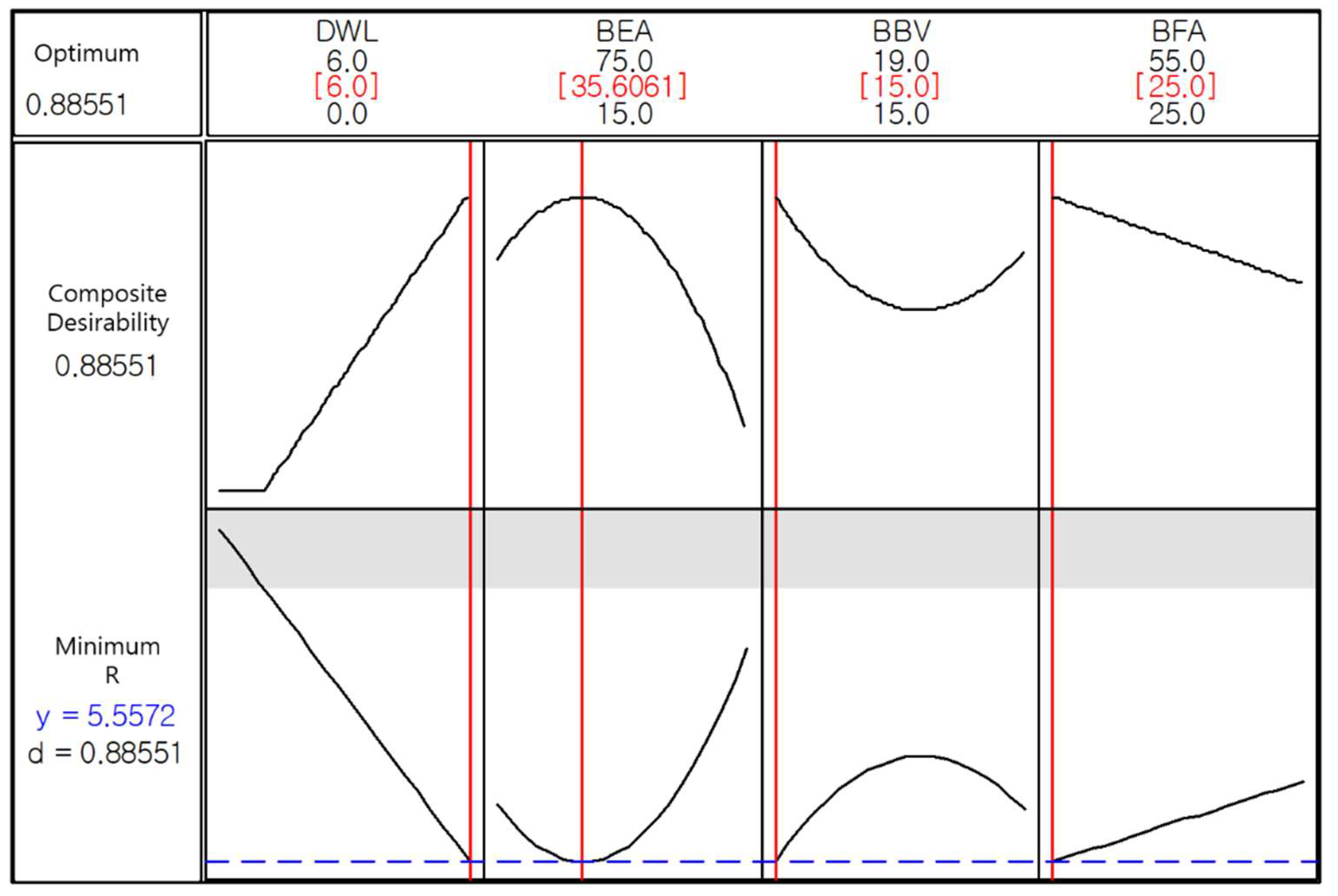
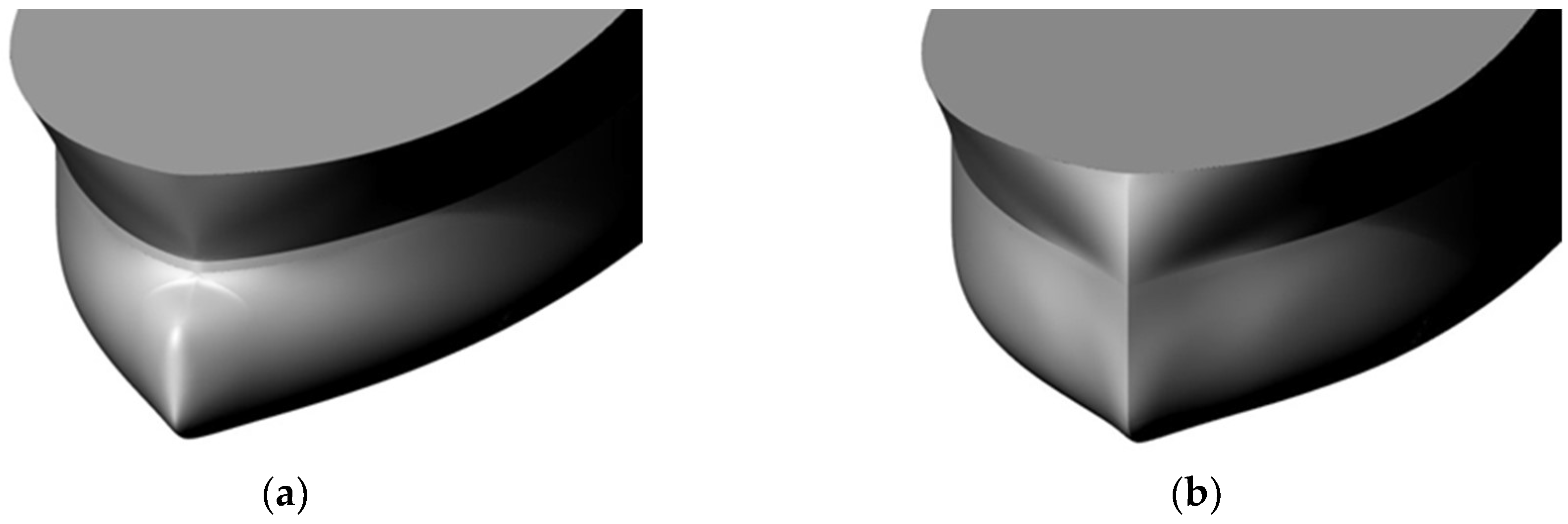
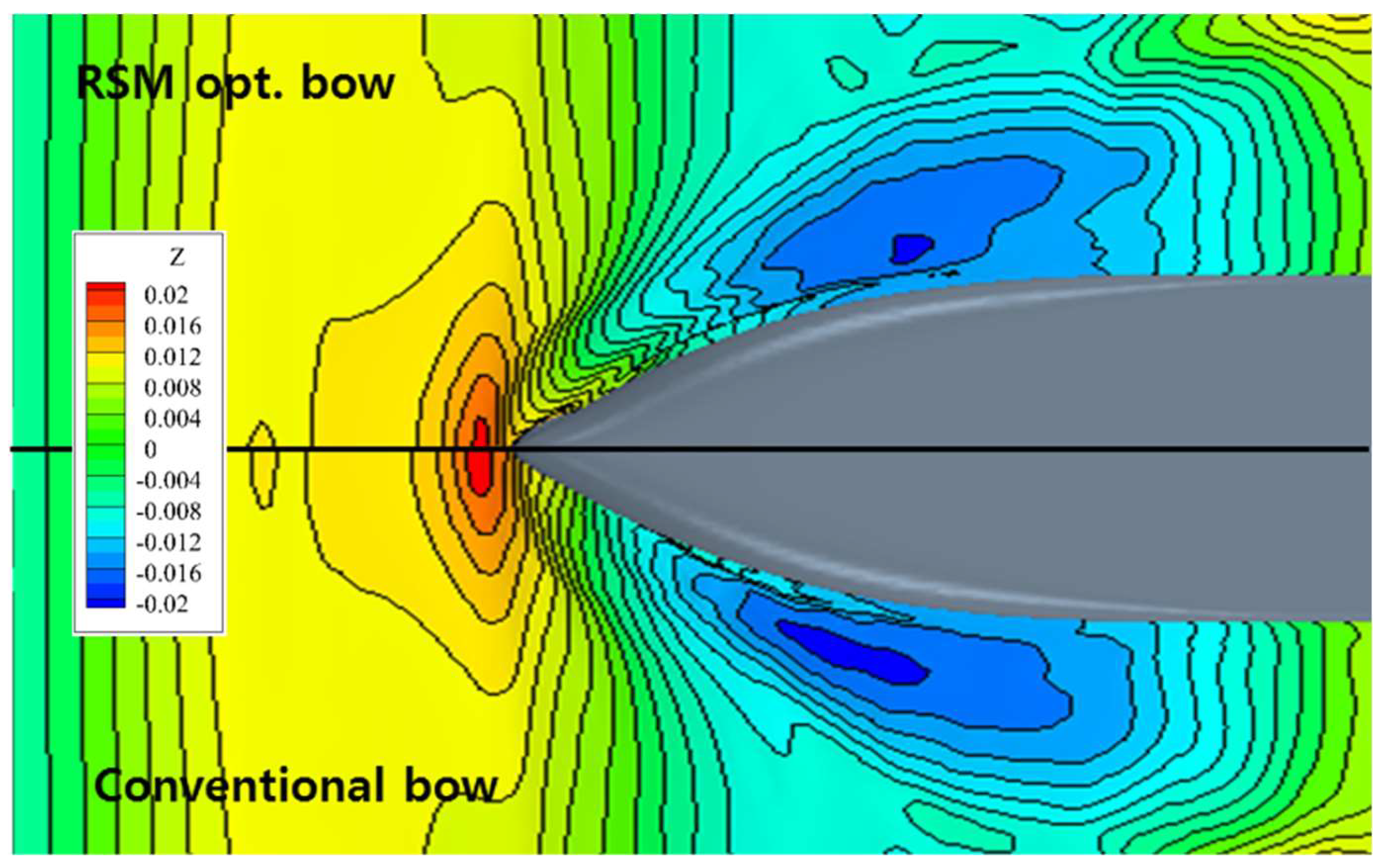
| Design Parameters | Symbol | Unit | Level 1 | Level 2 |
|---|---|---|---|---|
| Design Waterline Length | DWL | m | 0 | 6 |
| Bulbous Bow Height | BBH | m | 0 | 1.5 |
| Bow Entrance Angle | BEA | ° | 45 | 75 |
| Bulbous Bow Volume | BBV | % | 16 | 18 |
| Bow Flare Angle | BFA | ° | 30 | 55 |
| Principal Particulars | Symbol | Unit | Full Scale | Model Scale |
|---|---|---|---|---|
| Length overall | LOA | m | 250 | 6.87 |
| Length between perpendiculars | LBP | m | 239 | 6.57 |
| Beam | m | 44 | 1.21 | |
| Design draft | m | 13.6 | 0.374 | |
| Advance speed | m/s | 7.459 | 1.236 |
| Test Condition | Symbol | Unit | Full Scale | Model Scale |
|---|---|---|---|---|
| Wave length ratio | λ/L | 0.5 | ||
| Wave height | m | 4.0 | 0.110 | |
| Wave period | s | 8.748 | 1.45 | |
| Run No. | DWL (m) | BBH (m) | BEA (m) | BBV (m) | BFA (m) | Res. (N) | Dev. (%) |
|---|---|---|---|---|---|---|---|
| CASE 1 | 0 | 0.0 | 45 | 16 | 55 | 5.720 | −5.3 |
| CASE 2 | +6 | 0.0 | 75 | 16 | 55 | 5.932 | −1.8 |
| CASE 3 | +6 | +1.5 | 45 | 18 | 30 | 5.949 | −1.5 |
| CASE 4 | +6 | 0.0 | 75 | 18 | 30 | 5.908 | −2.2 |
| CASE 5 | 0 | +1.5 | 75 | 16 | 55 | 6.054 | +0.2 |
| CASE 6 | 0 | 0.0 | 75 | 18 | 55 | 6.446 | +6.7 |
| CASE 7 | 0 | +1.5 | 45 | 18 | 55 | 6.007 | −0.6 |
| CASE 8 | 0 | 0.0 | 45 | 18 | 30 | 6.339 | +4.9 |
| CASE 9 | +6 | +1.5 | 75 | 18 | 55 | 6.071 | +0.5 |
| CASE 10 | +6 | 0.0 | 45 | 18 | 55 | 6.024 | −0.3 |
| CASE 11 | 0 | 0.0 | 75 | 16 | 30 | 6.196 | +2.6 |
| CASE 12 | +6 | +1.5 | 75 | 16 | 30 | 5.910 | −2.2 |
| CASE 13 | +6 | 0.0 | 45 | 16 | 30 | 5.741 | −5.0 |
| CASE 14 | 0 | +1.5 | 75 | 18 | 30 | 6.409 | +6.1 |
| CASE 15 | +6 | +1.5 | 45 | 16 | 55 | 6.102 | +1.0 |
| CASE 16 | 0 | +1.5 | 45 | 16 | 30 | 6.192 | +2.5 |
| Design Parameters | Symbol | Unit | Level 1 | Level 2 | Level 3 |
|---|---|---|---|---|---|
| Design waterline length | DWL | m | 0 | 3 | 6 |
| Bow entrance angle | BEA | ° | 15 | 45 | 75 |
| Bulbous bow volume | BBV | % | 15 | 17 | 19 |
| Bow flare angle | BFA | ° | 25 | 40 | 55 |
© 2019 by the authors. Licensee MDPI, Basel, Switzerland. This article is an open access article distributed under the terms and conditions of the Creative Commons Attribution (CC BY) license (http://creativecommons.org/licenses/by/4.0/).
Share and Cite
Seok, W.; Kim, G.H.; Seo, J.; Rhee, S.H. Application of the Design of Experiments and Computational Fluid Dynamics to Bow Design Improvement. J. Mar. Sci. Eng. 2019, 7, 226. https://doi.org/10.3390/jmse7070226
Seok W, Kim GH, Seo J, Rhee SH. Application of the Design of Experiments and Computational Fluid Dynamics to Bow Design Improvement. Journal of Marine Science and Engineering. 2019; 7(7):226. https://doi.org/10.3390/jmse7070226
Chicago/Turabian StyleSeok, Woochan, Gwan Hoon Kim, Jeonghwa Seo, and Shin Hyung Rhee. 2019. "Application of the Design of Experiments and Computational Fluid Dynamics to Bow Design Improvement" Journal of Marine Science and Engineering 7, no. 7: 226. https://doi.org/10.3390/jmse7070226





